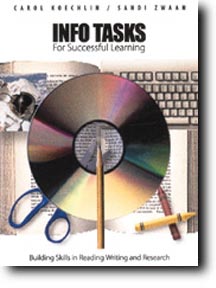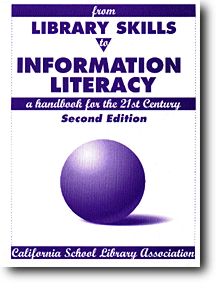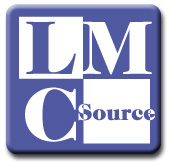 |
 |
 |
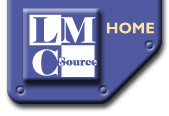 |

Information Literacy
David V. Loertscher, Carol Koechlin, and Sandi Zwaan; Hi Willow Research and Publishing; 2004; ISBN 0-931510-06-9; $35.00
Bird units are fill-in-the-blank library assignments, or reports; the result of which is copying or outright plagiarism. This book provides ways to ban such low-level activities and replace them with exciting learning experiences that link the library and technology into achievement. Models, sample units, forms, and links to popular educational practices such as Understanding by Design are provided. The models work K-12 and across all disciplines. They work when teachers are interested in going beyond the textbook and the lecture. They work extremely well in differentiated instruction and in classrooms where the students cannot understand the textbook. The models show how to integrate information literacy and technology into learning topics based on state standards. The book is a companion work to Build Your Own Information Literate School. It’s a guide for teachers as much as it is for librarians and technology specialists. Great for planning collaborative units and doing professional development with teachers.
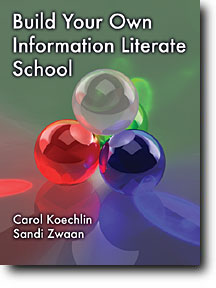 Build Your Own Information Literate School
Build Your Own Information Literate SchoolCarol Koechlin and Sandi Zwaan; Hi Willow Research and Publishing; 2003; ISBN 0-931510-89-9; $35.00
The book: Info Tasks has been well received across the country as a unique book for teaching information literacy. Now these excellent authors have written a more extensive and innovative method of teaching information literacy. While following a general information literacy model, each skill is a two-page spread of wonderful advice on how to teach and assess how well children and teens can practice what they are taught. But this book is very different! The authors present teaching tips for teaching each skill to novices, apprentices, and InfoStars (novice to advanced). Then they give examples from various curricular areas so that the guide can be used across the curriculum and across the grade levels. Their coverage not only covers traditional finding, locating and sorting information, but they tackle analysis and synthesis of information as well. Many useful worksheets provide ideas for teaching. According to David Loertscher this is the very best information literacy book to appear in years and is extremely useful and practical for elementary through high school because of its unique approach.
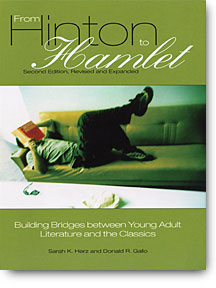 From Hinton to Hamlet, 2nd edition: Building Bridges between Young Adult Literature and the Classics
From Hinton to Hamlet, 2nd edition: Building Bridges between Young Adult Literature and the Classics
Sarah K. Herz and Donald R. Gallo; 2005; ISBN: 0-313-32452-2; Greenwood Press; Price: $40.00
The required classics in grades 7-12 are often too complex and removed from adolescent experience. This informative text uses thematic groupings built around recent young adult literature (YAL) as bridges to the classics. This second edition, which the authors have revised and greatly expanded, emphasizes the goal of helping teenagers become lifetime readers, as well as critical and confident readers. By pairing the required classics and young adult literature around common themes, the authors illustrate specific theme connections and include extensive lists of annotated YAL titles at the end of each classic title.
New to this second edition:
• Features more than 1,000 titles, hundreds published in the last five years.
• Thirty-three recent YAL titles are included as theme connectors among the twelve most frequently taught classics.
• Thematic units on “War: It’s Effects and Its Aftermath” and “The Great Depression,” including the “Dust Bowl” have been expanded.
• Many new annotated YAL titles added to Archetypes.
• A step-by-step approach to writing an Author Paper using YAL

Assessing Learning: Librarians and Teachers as Partners
Violet H. Harada and Joan M. Yoshina; 2005; ISBN: 1591582008; Libraries Unlimited; Price: $40.00
Focusing on the role of library media specialists in assessing student learning, this is the first full-length book written to address its practical application in the school library media center. It is an important book for school librarians to consider as they address their role as “teachers” in schools and the accountability issues associated with that role. It places students at the center of the assessment equation and addresses the following topics as they relate specifically to school library instructional programs: purposes of assessment, essential elements of assessment, knowing what to assess, multiple methods for assessment, and management and communication of assessment results. The book’s primary audiences are library media specialists and teachers in K-12 settings. It is also relevant for other educators, who are centrally involved in K-12 programs including district, regional and state library media coordinators, building level administrators, and library school educators. The authors cull from their own 30-year careers as library practitioners, university instructors, and workshop presenters to present doable, practical methods for the library media specialist to be involved in assessing student learning. Though this topic appears in the theoretical literature and is addressed in journal articles or chapters in contributed books, this is the first practical in-depth analysis for the school library field.
 The Power of Reading, Second Edition: Insights from the Research
The Power of Reading, Second Edition: Insights from the Research
Stephen D. Krashen; Libraries Unlimited; 2004; ISBN: 1591581699; Price: $25.00
Continuing the case for free voluntary reading set out in the book’s 1993 first edition, this new, updated, and much-looked-for second edition explores new research done on the topic in the last 10 years as well as looking anew at some of the original research reviewed.

Learning to Question to Wonder to Learn
Jamie McKenzie; FNO Press; 2005; Price: $20.00
This book shows how teachers can equip young ones with questioning strategies to wrestle with the most difficult decisions and problems.
For some four decades now, Jamie has been developing tools and models intended to strengthen student questioning and thinking.
In Learning to Question, Jamie shares his best insights about sharpening the questioning powers of the young, emphasizing practical classroom strategies that teachers can use on Monday morning. This book is meant to equip teachers to nurture the sense of wonder of all students while encouraging them to explore, uncover, discover, invent and decide.
Jamie shows how good teaching blends four elements: science, craft, art and alchemy. As teachers proceed through their careers, they deepen and extend their repertoires of effective teaching techniques in order to orchestrate and inspire student learning.
Inquiry Learning Through Librarian-Teacher Partnerships
Violet H. Harada and Joan M. Yoshina; 2004;
ISBN: 1-58683-134-8; Linworth Publishing; Price: $40.00
Begin a school-wide movement toward collaborative instruction and ultimate student success! Challenge yourself and. teachers to build learning environments that focus on realistic issues and themes. Build a strong case for the role of the library media specialist in implementing curriculum changes.
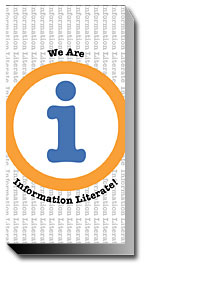 We Are Information Literate! The Video
We Are Information Literate! The VideoCathy Marriott; Hi Willow Research and Publishing; ISBN 0-931510-92-9; 2003; $35.00
The first longitudinal video record of actual children who as kindergartners do a research project “pick a pet” and then are interviewed as fifth-graders about projects and information literacy skills they know, understand, and use every day. Not a slick presentation – but an amazing documentary of what information literacy teaching is all about. Not only informative but an example of documentary evidence we should all be keeping.
INFO TASKS FOR SUCCESSFUL
LEARNING:
BUILDING SKILLS IN READING,
WRITING, AND RESEARCH
Carol Koechlin and Sandi Zwaan;
2001;
ISBN: 1-55138-133-8; $17.50
from Stenhouse Publishers
David Loertscher says of this book: “It’s the best book on information literacy published in 2001!” Why? It turns the library media specialist into a diagnostician. Start with a state standard; pull out the information task; then, turn alphabetically in this dictionary-type book to a page matching that task and you will find a one-page information literacy lesson awaiting as an idea starter. The ideas span:
- Evaluating information for relevance and validation.
- Sorting information to make connections.
- Working with information and testing ideas.
- Analyzing and synthesizing information for meaningful conclusions.
You will find your approach to teaching information literacy transformed.
 Information Literacy: A Review of the Research
Information Literacy: A Review of the Research
2nd Edition
by David V. Loertscher and Blanche Woolls
Hi Willow Research and Publishing
2002; $30.00
ISBN: 0-931510-80-5
The last major review of research on information literacy for school library media specialists was done by Christina Doyle in her 1994 monograph from ERIC titled Information Literacy in an Information Society. Now, the two authors have updated this critical area updating the Doyle work through March, 1999. Studies published in research journals, research retreats, both in the school library media field and in the larger field of education are included. The volume also includes studies done not only in th U.S. but in Canada, Australia, and in Great Britain. The authors not only review the research but offer numerous suggestions for translating that research into practice as school library media specialists educating young people. Designed for the serious practitioner and the researcher who wants to stay current.
View table of contents (requires Adobe Acrobat)
2nd edition
California School Library Association
Hi Willow Research and Publishing
ISBN 0-931510-67-8; 1997; $30.00
This popular and ground-breaking guide to information literacy and its incorporation into the school and library media center curriculum is now even more valuable as it provides models and strategies for working with regular and English learner students. With the rapid rise of new immigrants in our society, this guide demonstrates how all learners, no matter their background language, can profit from learning and information literacy model and applying it to their everyday life and to their educational quests.
The volume begins with a three-dimensional model of information literacy. The next chapter explores the various models of teaching from behaviorist to constructivist and the role of the library media specialist in collaborating with both teaching styles. The role of information literacy in both resource-based teaching and resource-based learning is explored.
The balance of the book provides very practical advice for integrating information literacy activities into a broad range of teaching and learning situations. Critical thinking activities, journaling, developing questions, building background, tapping the multiple intelligences are just a few of the ideas covered.
A valuable addition are rubrics for the assessment of information literacy and projects containing information literacy components.
A remarkable publication and an essential tool!
View table of contents (requires Adobe Acrobat)

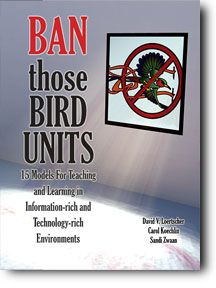 Ban Those Bird Units! 15 Models for Teaching and Learning in Information-rich and Technology-rich Environments
Ban Those Bird Units! 15 Models for Teaching and Learning in Information-rich and Technology-rich Environments